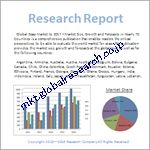目次
第1章.空間プロテオミクスの世界市場 エグゼクティブサマリー
1.1.空間プロテオミクスの世界市場規模・予測(2022~2032年)
1.2.地域別概要
1.3.セグメント別概要
1.3.1.製品別
1.3.2.技術別
1.3.3.ワークフロー別
1.3.4.サンプルタイプ別
1.3.5.最終用途別
1.4.主要動向
1.5.不況の影響
1.6.アナリストの提言と結論
第2章 空間プロテオミクスの世界市場世界の空間プロテオミクス市場の定義と調査前提条件
2.1.調査目的
2.2.市場の定義
2.3.調査の前提
2.3.1.包含と除外
2.3.2.限界
2.3.3.サプライサイド分析
2.3.3.1.入手可能性
2.3.3.2.インフラ
2.3.3.3.規制環境
2.3.3.4.市場競争
2.3.3.5.経済性(消費者の視点)
2.3.4.需要サイド分析
2.3.4.1.規制の枠組み
2.3.4.2.技術の進歩
2.3.4.3.環境への配慮
2.3.4.4.消費者の意識と受容
2.4.推定方法
2.5.調査対象年
2.6.通貨換算レート
第3章.空間プロテオミクスの世界市場ダイナミクス
3.1.市場促進要因
3.1.1.イメージング技術と質量分析技術の進歩
3.1.2.個別化医療とバイオマーカー探索の需要の高まり
3.1.3.腫瘍学と精密医療における研究投資の増加
3.2.市場の課題
3.2.1.空間プロテオミクス技術の高コスト
3.2.2.複雑なワークフローを処理するための限られた技術的専門知識
3.3.市場機会
3.3.1.アジア太平洋や中南米などの新興地域での拡大
3.3.2.データ分析における人工知能(AI)の統合
3.3.3.アカデミアと製薬企業とのコラボレーションの増加
第4章 空間プロテオミクスの世界世界の空間プロテオミクス市場産業分析
4.1.ポーターの5フォースモデル
4.1.1.サプライヤーの交渉力
4.1.2.バイヤーの交渉力
4.1.3.新規参入者の脅威
4.1.4.代替品の脅威
4.1.5.競合他社との競争
4.1.6.ポーターの5フォースモデルへの未来的アプローチ
4.1.7.ポーター5フォースのインパクト分析
4.2.PESTEL分析
4.2.1.政治的
4.2.2.経済的
4.2.3.社会的
4.2.4.技術的
4.2.5.環境
4.2.6.法律
4.3.主な投資機会
4.4.トップ勝ち組戦略
4.5.破壊的トレンド
4.6.業界専門家の視点
4.7.アナリストの提言と結論
第5章 空間プロテオミクスの世界市場空間プロテオミクスの世界市場規模・製品別予測(2022~2032年
5.1.セグメントダッシュボード
5.2.収益動向分析(百万米ドル)
5.2.1.インストルメンツ
5.2.2.消耗品
5.2.3.ソフトウェア
第6章 空間プロテオミクスの世界市場空間プロテオミクスの世界市場規模・技術別予測(2022~2032年
6.1.セグメントダッシュボード
6.2.収益動向分析(百万米ドル)
6.2.1.イメージングベース技術
6.2.2.質量分析ベースの技術
6.2.3.シーケンスベース技術
6.2.4.その他の技術
第7章 空間プロテオミクスの世界市場空間プロテオミクスの世界市場規模・予測(ワークフロー別)、2022~2032年
7.1.セグメントダッシュボード
7.2.収益動向分析(百万米ドル)
7.2.1.サンプル前処理
7.2.2.機器分析
7.2.3.データ分析
第8章 空間プロテオミクスの世界市場空間プロテオミクスの世界市場規模・予測(サンプルタイプ別)、2022~2032年
8.1.セグメントダッシュボード
8.2.収益動向分析(百万米ドル)
8.2.1.FFPE
8.2.2.新鮮凍結
第9章 空間プロテオミクスの世界市場空間プロテオミクスの世界市場規模・用途別予測(2022~2032年
9.1.セグメントダッシュボード
9.2.収益動向分析(百万米ドル)
9.2.1.学術・トランスレーショナルリサーチ機関
9.2.2.製薬・バイオテクノロジー企業
9.2.3.その他のエンドユーザー
第10章 空間プロテオミクスの世界市場空間プロテオミクスの世界市場規模・地域別予測(2022~2032年
10.1.北米
10.1.1.米国
10.1.2.カナダ
10.1.3.メキシコ
10.2.ヨーロッパ
10.2.1.ドイツ
10.2.2.イギリス
10.2.3.フランス
10.2.4.イタリア
10.2.5.スペイン
10.2.6.デンマーク
10.2.7.スウェーデン
10.2.8.ノルウェー
10.3.アジア太平洋
10.3.1.中国
10.3.2.日本
10.3.3.インド
10.3.4.韓国
10.3.5.オーストラリア
10.3.6.タイ
10.4.ラテンアメリカ
10.4.1.ブラジル
10.4.2.アルゼンチン
10.5.中東・アフリカ
10.5.1.南アフリカ
10.5.2.サウジアラビア
10.5.3.アラブ首長国連邦
10.5.4.クウェート
第11章.コンペティティブ・インテリジェンス
11.1.主要企業のSWOT分析
11.1.1.ナノストリング・テクノロジーズ
11.1.2.アコヤバイオサイエンス
11.1.3.10X Genomics
11.2.トップ市場戦略
11.3.企業プロフィール
11.3.1.ナノストリング・テクノロジーズ
11.3.2.アコヤバイオサイエンス
11.3.3.10X Genomics
11.3.4.ブルカー
11.3.5.フルイディグム・コーポレーション
11.3.6.パーキンエルマー
11.3.7.ダナハー
11.3.8.バイオテクネ
11.3.9.S2ジェノミクス社
11.3.10.セブンブリッジ ジェノミクス
第12章 研究プロセス研究プロセス
12.1.研究プロセス
12.1.1.データマイニング
12.1.2.分析
12.1.3.市場推定
12.1.4.バリデーション
12.1.5.出版
12.2.研究属性
表一覧
1.空間プロテオミクスの世界市場レポートスコープ
2.空間プロテオミクスの世界市場:地域別推計・予測、2022年~2032年(百万米ドル)
3.空間プロテオミクスの世界市場:製品別推定・予測、2022-2032年(USD Million)
4.空間プロテオミクスの世界市場:技術別、推計・予測、2022-2032年(USD Million)
5.空間プロテオミクスの世界市場:ワークフロー別、推計・予測、2022-2032年 (USD Million)
…
このリストは完全なものではなく、最終報告書には100以上の表が含まれる。このリストは最終成果物で更新される可能性があります。
図表リスト
1.空間プロテオミクスの世界市場調査手法
2.空間プロテオミクスの世界市場推定手法
3.世界市場規模推計・予測手法
4.空間プロテオミクスの世界市場主要動向(2023年
5.空間プロテオミクスの世界市場成長展望、2022-2032年
6.空間プロテオミクスの世界市場 ポーターの5フォースモデル
7.空間プロテオミクスの世界市場PESTEL分析
8.空間プロテオミクスの世界市場バリューチェーン分析
9.空間プロテオミクスの世界市場:地域別、2022年・2032年(百万米ドル)
…
このリストは完全なものではなく、最終報告書には50以上の図表が含まれます。このリストは最終成果物で更新される可能性があります。
Rising demand for advanced imaging and mass spectrometry technologies is driving market growth, enabling researchers to achieve unprecedented levels of resolution and specificity in protein analysis. The pharmaceutical and biotechnology sectors are increasingly adopting spatial proteomics for drug discovery and personalized medicine. For example, innovations such as Imaging Mass Cytometry (IMC), Multiplexed Ion Beam Imaging (MIBI), and Digital Spatial Profiling (DSP) have significantly expanded the capabilities of spatial proteomics, making it a critical tool in biomedical research.
The COVID-19 pandemic highlighted the importance of spatial proteomics in understanding disease mechanisms, particularly in studying viral-host interactions and immune responses. Increased funding for life sciences research post-pandemic has further propelled the adoption of spatial proteomics technologies. For instance, government initiatives like the Human BioMolecular Atlas Program (HuBMAP) have played a vital role in advancing spatial biology, fostering collaboration between academic institutions and market players.
North America dominated the spatial proteomics market in 2024, accounting for 49.13% of global revenue. The region’s advanced healthcare infrastructure, significant research investments, and presence of key market players contribute to its leadership. In contrast, the Asia Pacific region is expected to grow at the fastest CAGR of 15.80% over the forecast period, driven by expanding research capabilities, rising investments in healthcare infrastructure, and increasing demand for cancer research solutions.
The consumables segment held the largest revenue share of 56.19% in 2024, attributed to the rising demand for reagents, antibodies, and labeling kits essential for spatial proteomics experiments. The software segment is anticipated to witness the fastest growth, driven by the increasing need for sophisticated data analysis and visualization tools to process high-resolution spatial data.
Key market players are focusing on strategic initiatives such as product launches, mergers and acquisitions, and collaborations to enhance their market position. For instance, in September 2024, Lunaphore launched its spatial biology platform, COMET, in collaboration with Discovery Life Sciences to support clinical research efforts. Similarly, NanoString Technologies introduced the GeoMx IO Proteome Atlas, offering comprehensive spatial proteomics assays.
Major market players included in this report are:
• 10X Genomics
• Bruker
• Fluidigm Corporation
• NanoString Technologies, Inc.
• Akoya Biosciences, Inc.
• PerkinElmer
• Danaher
• Biotechne
• S2 Genomics, Inc.
• Seven Bridges Genomics Inc.
The detailed segments and sub-segments of the market are explained below:
By Product:
• Instruments
o Automated
o Semi-automated & Manual
• Consumables
• Software
By Technology:
• Imaging-based Technologies
• Mass Spectrometry-based Technologies
• Sequencing-based Technologies
• Other Technologies
By Workflow:
• Sample Preparation
• Instrumental Analysis
• Data Analysis
By Sample Type:
• FFPE
• Fresh Frozen
By End-use:
• Academic & Translational Research Institutes
• Pharmaceutical and Biotechnology Companies
• Other End-uses
By Region: North America:
• U.S.
• Canada
• Mexico
Europe:
• Germany
• UK
• France
• Italy
• Spain
• Denmark
• Sweden
• Norway
Asia Pacific:
• China
• Japan
• India
• South Korea
• Australia
• Thailand
Latin America:
• Brazil
• Argentina
Middle East & Africa:
• South Africa
• Saudi Arabia
• UAE
• Kuwait
Years considered for the study:
• Historical Year – 2022
• Base Year – 2023
• Forecast Period – 2024 to 2032
Key Takeaways:
• Market Estimates & Forecast for 10 years from 2022 to 2032.
• Annualized revenues and regional-level analysis for each market segment.
• Detailed geographical landscape with country-level analysis of major regions.
• Competitive landscape with insights on major players.
• Recommendations on future market strategies.
❖ 免責事項 ❖
http://www.globalresearch.jp/disclaimer

